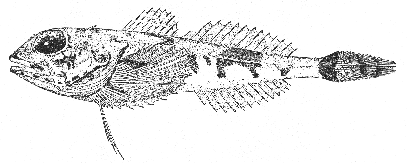Hook-eared sculpin Artediellus uncinatus (Reinhardt) 1833
ARCTIC SCULPIN
[Jordan and Evermann, 1896-1900, p. 1906, as Artediellus atlanticus Jordan and Evermann.]
Description—
The most distinctive feature of this species among local sculpins is the long hooklike spine on each cheek, pointing backward and upward, plainly shown in the illustration (fig. 226). There is also a short backward-pointing spine covered by a flap of skin at the upper corner of each gill cover, two short spines on the top of the nose between the two pairs of nostrils, and a pair of blunt knobs above the eyes. Head, mouth, and tapering body are of the usual sculpin form. The skin is smooth and naked. The spiny dorsal fin is short (7 to 9 spines) and rounded in outline, the soft dorsal fin is about twice as long (13 rays), and the anal (11-12 rays) is a little shorter than the soft dorsal, which it resembles in outline and under which it stands. Each ventral fin consists of three long rays that reach back nearly to the vent; the pectorals, wide at the base and rounded in outline, reach beyond the beginning of the soft dorsal when they are laid back, and the caudal fin is narrower than it is in the commoner Gulf of Maine sculpins. The jaws and the roof of the mouth are armed with several series of small bristle-like teeth.
[page 441]Color—
Preserved specimens are mottled with dark and pale brown, sometimes with a reddish tinge, and most of them have a blotch at the base of the caudal fin. All the fins are grayish or blackish, with oblique or vertical pale cross bands.
Size—
This is one of the smallest of sculpins, growing to a length of only about 4 inches.
General range—
This is a cold-water fish known from Labrador and the west coast of Greenland to Cape Cod in the western Atlantic; also in the littoral waters of arctic Europe, of Siberia, and of Greenland.[60]
Occurrence in the Gulf of Maine—
This sculpin, formerly thought to be rare in the Gulf of Maine, is now known to be generally distributed there in depths greater than 20 to 30 fathoms. It was dredged in numbers in the deeper parts of Massachusetts Bay many years ago. And we have since taken it repeatedly near Mount Desert; off Cape Elizabeth; in the trough between Jeffreys Ledge and the coast; around Cashes Ledge; along the northern slopes of Georges Bank; in the southeastern part of the basin of the Gulf; and at the entrance to the deep gully between Georges and Browns Banks, in depths ranging from 20 to 150 fathoms. Individual trawl hauls have yielded up to 6 or 8 specimens, both on hard bottom and on soft.
To the eastward and northward it has been taken off Cape Sable; at a number of places off the outer coast of Nova Scotia; and on the Newfoundland Banks, at depths of 50 to 190 fathoms.[61]
It is common enough in the Gulf of St. Lawrence for Huntsman to have classed it as a characteristic inhabitant of the icy intermediate water layer on the Banks, [62] while Vladykov and Tremblay[63] have reported it from the estuary of the St. Lawrence River near Trois Pistoles; it has been reported from Hamilton Inlet on the outer coast of Labrador;[64] and doubtless it will be found farther north, when the fish fauna of the outer Labrador coast has been explored more thoroughly, for it is known from West Greenland.
Presumably, it is resident in small numbers wherever found, sculpins not being migratory, but nothing whatever is known of its way of life.
[60] After examining specimens from New England waters and comparing them with published drawings of European fish, we can find no significant differences between the hook-eared sculpins of the two sides of the Atlantic.
[61] For localities of record off outer Nova Scotia and on the Newfoundland Banks, see Goode and Bean, Smithson. Contrib. Knowl., vol. 30, 1895, p. 268; also Reports, Newfoundland Fishery Research Commission, vol. 1, No. 4, 1932, p. 108; vol. 2, No. 1, 1933, p. 125.
[62] Trans. Roy. Soc. Canada, Ser. 3, vol. 12, Sect. 4, 1918, p. 63, as Centridermichthys uncinatus.
[63] Natural. Canad., vol. 62, 1935, p. 79.
[64] Kendall, Proc. Portland Soc. Nat. Hist., vol. 2, 1909, p. 217.
